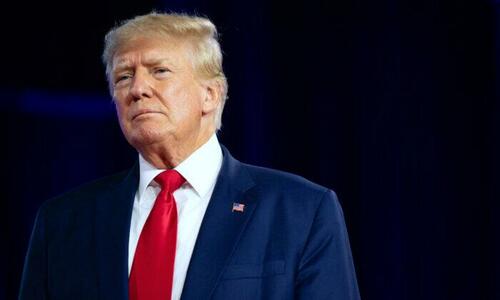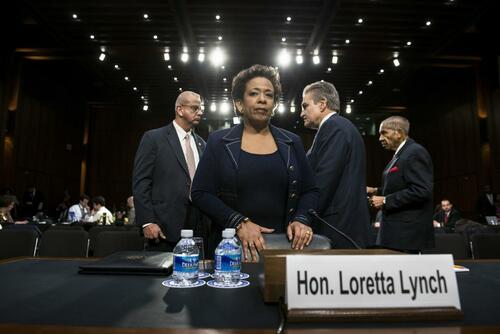
Authored by Jeff Carlson via The Epoch Times (emphasis ours),
Jan. 12, 2017, has proven to be an incredibly important date in American politics.

It was on this date that Igor Dancehnko’s soon-to-be FBI handler, Kevin Helson, sent an email regarding Danchenko with the heading: “Plan to convert into [confidential human source].” Danchenko, of course, was the primary source for former British spy Christopher Steele’s fictitious dossier on the 2016 Trump presidential campaign.
It was also on this same day that Department of Justice (DOJ) Inspector General Michael Horowitz announced the initiation of a sweeping review into actions taken by the DOJ and FBI in advance of the 2016 election. This probe by Horowitz—either by design or by accident—effectively tied up any outside probes into the FBI’s actions for two years.
Also, on the same date, the Foreign Intelligence Surveillance Act (FISA) warrant on former Trump campaign adviser Carter Page was renewed for the first time.
Of particular note is the role of late Sen. John McCain (R-Ariz.) in the events leading up to that day. Without McCain’s silent endorsement and the efforts by Kramer, it’s unlikely the dossier could have been published as a prelude to the events of Jan. 12. Notably, the dossier’s publication coincided with a CNN article declaring that “Intel chiefs presented [candidate Donald] Trump with claims of Russian efforts to compromise him.”
Just seven days earlier, on Jan. 5, 2017, top intelligence officials, including then-FBI Director James Comey, then-CIA Director John Brennan, then-Director of National Intelligence James Clapper, and then-Director of the National Security Agency (NSA) Michael Rogers had briefed outgoing President Barack Obama on the ICA report. Following the official meeting, Comey stayed behind to brief Obama on the dossier. It was at this meeting that Obama stated that he wanted his team to be “mindful to ascertain if there is any reason that we cannot share information fully as it relates to Russia” with the incoming Trump administration.

The next day, Comey and other officials including Clapper briefed President-elect Trump and his national security team on the Intelligence Community Assessment. During this portion of the meeting, the Steele dossier was mentioned in passing.
It was here that retired Lt. Gen. Michael Flynn, the incoming national security adviser in the Trump administration, asked whether the FBI had dug into Steele’s sub-sources. Flynn’s probing questions may have precipitated his subsequent political demise at the hands of Comey.
Comey would stay behind after the initial meeting to brief Trump more fully on the dossier. Comey would later tell CNN’s Jake Tapper that he only briefed Trump on the “salacious” parts of the dossier because “that was the part that the leaders of the intelligence community agreed he needed to be told about.” News of the intelligence briefing to Trump was leaked hours later to the media.
Then on Jan. 12, The New York Times reported on then-Attorney General Loretta Lynch’s signing of new NSA Rules and the increased latitude of the NSA to share intercepted communications with the Intelligence Community.
This unprecedented new order significantly relaxed longstanding limits on the dissemination of information gathered by the NSA’s powerful surveillance operations, granting broad latitude to the Intelligence Community with regard to interagency sharing of information. The order had been officially signed into effect on Jan. 3, 2017, by Lynch. As we know with hindsight, leaks from the Intelligence Community would begin in earnest. And those leaks would plague the Trump administration for the next four years.

It was on the same day of Lynch’s signing of the new Executive Order that Schumer made his now infamous statement on NBC’s “Rachel Maddow Show,” where he said that if “you take on the Intelligence Community they have six ways from Sunday at getting back at you.” Without any trace of irony, Schumer then stated that without the Intelligence Community, the alleged Russian hacking of the 2016 presidential election would never have been discovered. In effect, Schumer was publicly warning the incoming Trump administration to stand down or the Intelligence Community would declare war on it.
Also on Jan. 12, Flynn’s Dec. 29, 2016, call with Russian Ambassador Sergey Kislyak was the subject of an article published by The Washington Post. The article portrayed Flynn as undermining Obama’s Russian sanctions and raised the possibility that Flynn had violated the Logan Act, an obscure, 200-year-old law. Interestingly, it was then-Vice President Joe Biden who first suggested using the Logan Act against Flynn at the Jan. 5 White House meeting with Comey. In 2020, declassified transcripts of Flynn’s call with Kislyak revealed that Flynn never once talked about sanctions.
It was also on Jan. 12 that James H. Baker, the director of the Defense Department’s Office of Net Assessment (ONA), suddenly issued a series of charges against Adam Lovinger, a strategic affairs analyst. The timing of these charges is of great importance, as it was on this same day that Flynn, now heading the National Security Council for the Trump administration, officially invited Lovinger to leave the ONA and join the National Security Council as a senior director. Baker filed four separate charges against Lovinger.

The reason for the targeting of Lovinger appears evident. Lovinger had grown increasingly concerned over the ONA’s use of outside contractors—in particular, those of a prominent FBI source, Stefan Halper. In 2016, Lovinger wrote a series of emails to Baker, who had recently been appointed by Obama’s defense secretary. In October 2016, Lovinger wrote to Baker, identifying Halper as a particular source of contractual concern, writing of “the moral hazard associated with the contracting of Stefan Halper.” Lovinger’s lawyer, Sean Bigley, would later state that Halper was being used “to go out essentially and engage with foreign government officials. As a contractor, that’s totally illegal.”
Lovinger would continue to criticize the use of outside contractors. In a March 3, 2017, memo, Lovinger noted, “There has never been an external review of these contractors’ research products. … It is now clear that over several decades, the office transferred millions of dollars to inexperienced and unqualified contractors.” On May 1, 2017, Lovinger was notified that his top-secret clearance had been suspended. He was the second Trump official to lose his security clearance. The loss of a security clearance is a significant matter, as it’s a requirement for many senior positions. Lovinger was then directed to leave the National Security Council and return to the Pentagon immediately.
The target of Lovinger’s complaints, Halper, met with the FBI on Aug. 11 and 12, 2016, shortly after the FBI had formally opened their July 31, 2016, Crossfire Hurricane investigation into the Trump campaign. As it turns out, Halper just so happened to have direct knowledge of two of the three men considered subjects of Crossfire Hurricane—including Page, whom Halper had met with twice during the month of July. Halper would later fashion a meeting in London with Trump campaign advisor George Papadopoulos, the one person of the three that he didn’t already know. But Halper also fabricated information on another man who was not yet being looked at by the FBI—Flynn.
Read more here...
Authored by Jeff Carlson via The Epoch Times (emphasis ours),
Jan. 12, 2017, has proven to be an incredibly important date in American politics.

It was on this date that Igor Dancehnko’s soon-to-be FBI handler, Kevin Helson, sent an email regarding Danchenko with the heading: “Plan to convert into [confidential human source].” Danchenko, of course, was the primary source for former British spy Christopher Steele’s fictitious dossier on the 2016 Trump presidential campaign.
It was also on this same day that Department of Justice (DOJ) Inspector General Michael Horowitz announced the initiation of a sweeping review into actions taken by the DOJ and FBI in advance of the 2016 election. This probe by Horowitz—either by design or by accident—effectively tied up any outside probes into the FBI’s actions for two years.
Also, on the same date, the Foreign Intelligence Surveillance Act (FISA) warrant on former Trump campaign adviser Carter Page was renewed for the first time.
Of particular note is the role of late Sen. John McCain (R-Ariz.) in the events leading up to that day. Without McCain’s silent endorsement and the efforts by Kramer, it’s unlikely the dossier could have been published as a prelude to the events of Jan. 12. Notably, the dossier’s publication coincided with a CNN article declaring that “Intel chiefs presented [candidate Donald] Trump with claims of Russian efforts to compromise him.”
Just seven days earlier, on Jan. 5, 2017, top intelligence officials, including then-FBI Director James Comey, then-CIA Director John Brennan, then-Director of National Intelligence James Clapper, and then-Director of the National Security Agency (NSA) Michael Rogers had briefed outgoing President Barack Obama on the ICA report. Following the official meeting, Comey stayed behind to brief Obama on the dossier. It was at this meeting that Obama stated that he wanted his team to be “mindful to ascertain if there is any reason that we cannot share information fully as it relates to Russia” with the incoming Trump administration.

The next day, Comey and other officials including Clapper briefed President-elect Trump and his national security team on the Intelligence Community Assessment. During this portion of the meeting, the Steele dossier was mentioned in passing.
It was here that retired Lt. Gen. Michael Flynn, the incoming national security adviser in the Trump administration, asked whether the FBI had dug into Steele’s sub-sources. Flynn’s probing questions may have precipitated his subsequent political demise at the hands of Comey.
Comey would stay behind after the initial meeting to brief Trump more fully on the dossier. Comey would later tell CNN’s Jake Tapper that he only briefed Trump on the “salacious” parts of the dossier because “that was the part that the leaders of the intelligence community agreed he needed to be told about.” News of the intelligence briefing to Trump was leaked hours later to the media.
Then on Jan. 12, The New York Times reported on then-Attorney General Loretta Lynch’s signing of new NSA Rules and the increased latitude of the NSA to share intercepted communications with the Intelligence Community.
This unprecedented new order significantly relaxed longstanding limits on the dissemination of information gathered by the NSA’s powerful surveillance operations, granting broad latitude to the Intelligence Community with regard to interagency sharing of information. The order had been officially signed into effect on Jan. 3, 2017, by Lynch. As we know with hindsight, leaks from the Intelligence Community would begin in earnest. And those leaks would plague the Trump administration for the next four years.

It was on the same day of Lynch’s signing of the new Executive Order that Schumer made his now infamous statement on NBC’s “Rachel Maddow Show,” where he said that if “you take on the Intelligence Community they have six ways from Sunday at getting back at you.” Without any trace of irony, Schumer then stated that without the Intelligence Community, the alleged Russian hacking of the 2016 presidential election would never have been discovered. In effect, Schumer was publicly warning the incoming Trump administration to stand down or the Intelligence Community would declare war on it.
Also on Jan. 12, Flynn’s Dec. 29, 2016, call with Russian Ambassador Sergey Kislyak was the subject of an article published by The Washington Post. The article portrayed Flynn as undermining Obama’s Russian sanctions and raised the possibility that Flynn had violated the Logan Act, an obscure, 200-year-old law. Interestingly, it was then-Vice President Joe Biden who first suggested using the Logan Act against Flynn at the Jan. 5 White House meeting with Comey. In 2020, declassified transcripts of Flynn’s call with Kislyak revealed that Flynn never once talked about sanctions.
It was also on Jan. 12 that James H. Baker, the director of the Defense Department’s Office of Net Assessment (ONA), suddenly issued a series of charges against Adam Lovinger, a strategic affairs analyst. The timing of these charges is of great importance, as it was on this same day that Flynn, now heading the National Security Council for the Trump administration, officially invited Lovinger to leave the ONA and join the National Security Council as a senior director. Baker filed four separate charges against Lovinger.

The reason for the targeting of Lovinger appears evident. Lovinger had grown increasingly concerned over the ONA’s use of outside contractors—in particular, those of a prominent FBI source, Stefan Halper. In 2016, Lovinger wrote a series of emails to Baker, who had recently been appointed by Obama’s defense secretary. In October 2016, Lovinger wrote to Baker, identifying Halper as a particular source of contractual concern, writing of “the moral hazard associated with the contracting of Stefan Halper.” Lovinger’s lawyer, Sean Bigley, would later state that Halper was being used “to go out essentially and engage with foreign government officials. As a contractor, that’s totally illegal.”
Lovinger would continue to criticize the use of outside contractors. In a March 3, 2017, memo, Lovinger noted, “There has never been an external review of these contractors’ research products. … It is now clear that over several decades, the office transferred millions of dollars to inexperienced and unqualified contractors.” On May 1, 2017, Lovinger was notified that his top-secret clearance had been suspended. He was the second Trump official to lose his security clearance. The loss of a security clearance is a significant matter, as it’s a requirement for many senior positions. Lovinger was then directed to leave the National Security Council and return to the Pentagon immediately.
The target of Lovinger’s complaints, Halper, met with the FBI on Aug. 11 and 12, 2016, shortly after the FBI had formally opened their July 31, 2016, Crossfire Hurricane investigation into the Trump campaign. As it turns out, Halper just so happened to have direct knowledge of two of the three men considered subjects of Crossfire Hurricane—including Page, whom Halper had met with twice during the month of July. Halper would later fashion a meeting in London with Trump campaign advisor George Papadopoulos, the one person of the three that he didn’t already know. But Halper also fabricated information on another man who was not yet being looked at by the FBI—Flynn.
Read more here…





